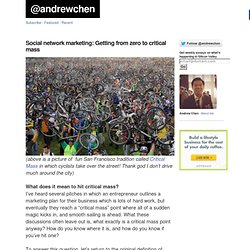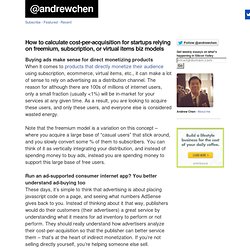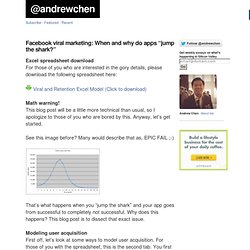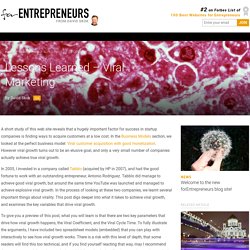

Social network marketing: Getting from zero to critical mass. (above is a picture of fun San Francisco tradition called Critical Mass in which cyclists take over the street!

Thank god I don’t drive much around the city) What does it mean to hit critical mass? I’ve heard several pitches in which an entrepreneur outlines a marketing plan for their business which is lots of hard work, but eventually they reach a “critical mass” point where all of a sudden magic kicks in, and smooth sailing is ahead. What these discussions often leave out is, what exactly is a critical mass point anyway? How do you know where it is, and how do you know if you’ve hit one? To answer this question, let’s return to the original definition of “critical mass” from the Physics world: The smallest mass of a fissionable material that will sustain a nuclear chain reaction at a constant level1. What does fissionable material means? That’s one way of viewing it, although I don’t believe that’s what most people mean.
How to calculate cost-per-acquisition for startups relying on freemium, subscription, or virtual items biz models. Buying ads make sense for direct monetizing products When it comes to products that directly monetize their audience using subscription, ecommerce, virtual items, etc., it can make a lot of sense to rely on advertising as a distribution channel.

The reason for although there are 100s of millions of internet users, only a small fraction (usually <1%) will be in-market for your services at any given time. As a result, you are looking to acquire these users, and only these users, and everyone else is considered wasted energy. Note that the freemium model is a variation on this concept – where you acquire a large base of “casual users” that stick around, and you slowly convert some % of them to subscribers. You can think of it as vertically integrating your distribution, and instead of spending money to buy ads, instead you are spending money to support this large base of free users. Run an ad-supported consumer internet app? Facebook viral marketing: When and why do apps ?jump the shark? Excel spreadsheet download For those of you who are interested in the gory details, please download the following spreadsheet here: Viral and Retention Excel Model (Click to download) Math warning!

This blog post will be a little more technical than usual, so I apologize to those of you who are bored by this. Anyway, let’s get started. See this image before? That’s what happens when you “jump the shark” and your app goes from successful to completely not successful. Modeling user acquisition First off, let’s look at some ways to model user acquisition. Invite conversion rate % = 10%Average invites per person = 8.00Initial user base = 10,000Carrying capacity = 100,000 (note that these are just example numbers) To understand how these constants work, you basically want to think about how viral marketing works. That means that in the first time period, you have 10k. U(t) = u(0) * (1 + i * conv)^t where u(0) = 10k, i = 8.00, conv = 10%, and t is the # of time periods. Lessons Learned – Viral Marketing. A short study of this web site reveals that a hugely important factor for success in startup companies is finding ways to acquire customers at a low cost.

In the Business Models section, we looked at the perfect business model: Viral customer acquisition with good monetization. However viral growth turns out to be an elusive goal, and only a very small number of companies actually achieve true viral growth. In 2005, I invested in a company called Tabblo (acquired by HP in 2007), and had the good fortune to work with an outstanding entrepreneur, Antonio Rodriguez. Tabblo did manage to achieve good viral growth, but around the same time YouTube was launched and managed to achieve explosive viral growth. In the process of looking at these two companies, we learnt several important things about virality. To give you a preview of this post, what you will learn is that there are two key parameters that drive how viral growth happens, the Viral Coefficient, and the Viral Cycle Time. A Spreadsheet Model for Viral Growth — Mark de Visser. When you are working to build your personal brand, it is important that you contribute relevant and timely information about your topic of interest.

I assume you have chosen a topic to which you can add value based on your passion, skill and passion. But a large part of your ability to be relevant and timely comes from the hard work you put in research, writing and distribution/promotion of your content. And if you are like most of us, you have only limited time to dedicate to your branding work, so being efficient and finding the right tools will determine whether your efforts succeed or not. There are great tools to help you save time and make it easier to get your brand out. And many of these tools are free. The first step of your daily routine should be to get an update on the news in your market segment. The major news in politics, business and finance is generally released by the major news channels. Such tools are called “feed readers”, “RSS readers” or “aggregators”. Add Star.